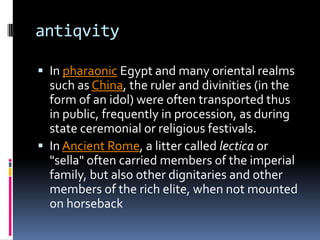Litter vehicles
- 2. Litter vehicles ? The litter is a class of wheelless vehicles, a type of human-powered transport, for the transport of persons. Examples of litter vehicles include lectica (ancient Rome), jiao [ ―Î] (China), ki?u (Vietnam), sedan chair (England), litera (Spain), palanquin (France and India), liteira (Portugal), Woh ( , Chinese style known as giao ) (Thailand), gama (Korea), kago and norimono (Japan) and taht?revan (Turkey).
- 3. definitions ? A simple litter, often called a king carrier, consists of a sling attached along its length to poles or stretched inside a frame. The poles or frame are carried by porters in front and behind. Such simple litters are common on battlefields and emergency situations, where terrain prohibits wheeled vehicles from carrying away the dead and wounded.
- 4. Korean gama A Korean gama, circa 1890
- 5. antiqvity ? In pharaonic Egypt and many oriental realms such as China, the ruler and divinities (in the form of an idol) were often transported thus in public, frequently in procession, as during state ceremonial or religious festivals. ? In Ancient Rome, a litter called lectica or "sella" often carried members of the imperial family, but also other dignitaries and other members of the rich elite, when not mounted on horseback
- 6. Sedan chair An English sedan chair (circa late 18th century) at Eaton Hall
- 7. china ? In Han China the elite travelled in light bamboo seats supported on a carrier's back like a backpack. In the Northern Wei Dynasty and the Northern and Southern Song Dynasties, wooden carriages on poles appear in painted landscape scrolls. ? A commoner used a wooden or bamboo civil litter (Chinese: Ãņ―Î; pinyin: min2 jiao4), while the mandarin class used an official litter (Chinese: đŲ―Î; pinyin: guan1 jiao4) enclosed in silk curtains. ? The chair with perhaps the greatest importance was the bridal chair. A traditional bride is carried to her wedding ceremony by a "shoulder carriage" (Chinese: žįÓß; pinyin: jiĻĄn yĻē), usually hired. These were lacquered in an auspicious shade of red, richly ornamented and gilded, and were equipped with red silk curtains to screen the bride from onlookers.[2]
- 8. Sedan chair (china) A public sedan chair in hong kong
- 9. South asia ? A palanquin, also known as palkhi, is a covered sedan chair (or litter) carried on four poles. It derives from the Sanskrit word for a bed or couch, pa:lanka. ? Palanquins are mentioned in literature as early as the Ramayana (c. 250BC). ? Palanquins began to fall out of use after rickshaws (on wheels, more practical) were introduced in the 1930s
- 10. plaquin A photo of country made palanquin at Varanasi. C. 1890s
- 11. indonasia ? In traditional Javanese society, the generic palanquin or joli was a wicker chair with a canopy, attached to two poles, and borne on men's shoulders, and was available for hire to any paying customer.[3] As a status marker, gilded throne-like palanquins, or jempana, were originally reserved solely for royalty, and later co-opted by the Dutch, as a status marker: the more elaborate the palanquin, the higher the status of the owner. The joli was transported either by hired help, by nobles' peasants, or by slaves.
- 12. joli A bride is being carried in a joli

![Litter vehicles
? The litter is a class of wheelless vehicles, a
type of human-powered transport, for the
transport of persons. Examples of litter
vehicles include lectica (ancient Rome), jiao [
―Î] (China), ki?u (Vietnam), sedan chair
(England), litera (Spain), palanquin (France
and India), liteira (Portugal), Woh ( ,
Chinese style known as giao ) (Thailand),
gama (Korea), kago and norimono (Japan)
and taht?revan (Turkey).](https://image.slidesharecdn.com/littervehicles-121129050523-phpapp01/85/Litter-vehicles-2-320.jpg)




![china
? In Han China the elite travelled in light bamboo seats supported
on a carrier's back like a backpack. In the Northern Wei Dynasty
and the Northern and Southern Song Dynasties, wooden
carriages on poles appear in painted landscape scrolls.
? A commoner used a wooden or bamboo civil litter (Chinese: Ãņ―Î;
pinyin: min2 jiao4), while the mandarin class used an official litter
(Chinese: đŲ―Î; pinyin: guan1 jiao4) enclosed in silk curtains.
? The chair with perhaps the greatest importance was the bridal
chair. A traditional bride is carried to her wedding ceremony by a
"shoulder carriage" (Chinese: žįÓß; pinyin: jiĻĄn yĻē), usually hired.
These were lacquered in an auspicious shade of red, richly
ornamented and gilded, and were equipped with red silk curtains
to screen the bride from onlookers.[2]](https://image.slidesharecdn.com/littervehicles-121129050523-phpapp01/85/Litter-vehicles-7-320.jpg)



![indonasia
? In traditional Javanese society, the generic
palanquin or joli was a wicker chair with a
canopy, attached to two poles, and borne on
men's shoulders, and was available for hire to
any paying customer.[3] As a status
marker, gilded throne-like palanquins, or
jempana, were originally reserved solely for
royalty, and later co-opted by the Dutch, as a
status marker: the more elaborate the
palanquin, the higher the status of the owner.
The joli was transported either by hired help, by
nobles' peasants, or by slaves.](https://image.slidesharecdn.com/littervehicles-121129050523-phpapp01/85/Litter-vehicles-11-320.jpg)
